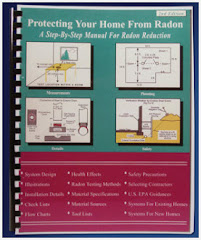Thursday, January 19, 2012
Minnesota Radon Video
Wednesday, January 11, 2012
Passing Radon Test
I was excited to recently receive passing radon test results for my last radon job in Nashville in December of '011. We got radon down to 2.8 pCi/L (4.0 Max. EPA recommended) Here's the link to a description of that job: Crawlspace
Thursday, January 5, 2012
Thursday, December 22, 2011
HRV Maintenance
I returned to a Nashville residence for my 1 free maintenance call on a heat recovery ventilator I installed in the summer. I had wanted to return anyway, because I wasn't crazy about the zip ties I had used to secure the ducting to the unit. They had been to short for the 8" diameter sleeves, about 24", so I picked up some 36" heavy duty zip ties at Home Depot on the way over. This is the Fantech SHR-2004 model:
 |
| Air intake vent through the outside wall |
 |
| Looks like the screen on the intake vent is pretty dirty! |
 |
| Exhaust Vent showed plenty of outflow. |
 |
| Duct tape for cleaning the vent screen |
 |
| A little debris from the intake vent screen |
 |
| 36" zip-ties are plenty long for a secure grip for the ducting |
 |
| This duct is securely held in place for life! |
 |
| Time to open the unit itself |
 |
| Flip the latches down and out to open the door. |
 |
| The HRV Core |
 |
| Slide it out..... |
 |
| Vacuum the screens, or "soak in soapy water for 3 hours" if super-dirty |
 |
| The ever-present dead insect population |
 |
| Slide core back into place after cleaning |
 |
| Slide door on the hinges on top from left to right |
 |
| Close latches |
 |
| Good for another year of radon removal |
Monday, December 19, 2011
Core Drilling
Often I have requests to drill under the concrete section of a house from the outside. Here is how it is done:
Saturday, December 17, 2011
Sealing Your Crawlspace
I thought I was finished with radon work for 2011, but I had a follow-up visit to a home where the radon levels have stubbornly remained above 4.0. This time I concentrated on sealing the existing vapor barrier in the crawlspace. After about 4 hours of taping and sealing, I got the vacuum gauge to show a slight increase in suction for my efforts:
Manometer/Vacuum Gauge at the Start
Sand and gravel helps seal difficult areas around cement pillars
Leftover tile pieces serve to seal the perimeter
Specialty seam tape for sealing tears and other openings
Gravel for sealing openings around the water heater
Bricks circa 1910 seal off the sloppy edges
A hair-increase in vacuum is actually significant for this size area!
Wednesday, December 7, 2011
Crawlspace Radon
I had to return to a property recently, because our post-radon test showed radon levels in their basement apartment to be about .7 above EPA safe limits, although upstairs levels tested safe. The apartment is next to the large crawlspace, and I was to attempt to dig under the basement concrete slab horizontally, from the crawlspace.
Unfortunately, I could find no gravel layer from the outside, so I have to return again tomorrow, to attempt to drill directly through the concrete floor from inside the apartment to find that gravel layer. If we find that there is no gravel layer, the only alternative will be to install a heat recovery ventilator.
Unfortunately, I could find no gravel layer from the outside, so I have to return again tomorrow, to attempt to drill directly through the concrete floor from inside the apartment to find that gravel layer. If we find that there is no gravel layer, the only alternative will be to install a heat recovery ventilator.
Digging below the foundation
Nothing but concrete - on dirt
Current vacuum levels
Sealing loose sections with sand raised vacuum levels a bit....
Our original opening was sealed back up
Some loose tile helps seal the edges
Sand is also good for sealing loose edges of the vapor-barrier
Sand seals around the base of the A/C unit
A pillar is a leaky spot until we pour sand around it.
Placed a trim ring around the pipe exit
Subscribe to:
Posts (Atom)





























